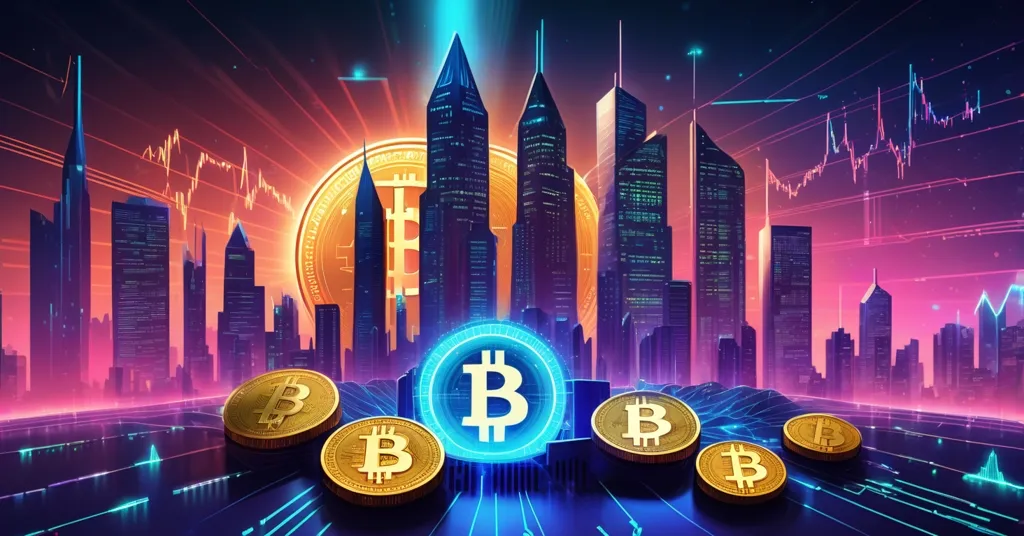Altseason 2025: Altcoin ETFs Crucial for Crypto Rally, Warns Bitfinex Alpha

Altseason 2025: Why Altcoin ETFs Are Key to a Crypto Rally, Says Bitfinex Alpha
Bitcoin and Ethereum are soaking up the spotlight with institutional money flooding into their ETFs, but if you’re waiting for altcoins to ignite the next big rally, you might be in for a long wait. A new report from Bitfinex Alpha argues that a true altseason—where smaller, riskier cryptocurrencies surge ahead—won’t happen until regulators approve exchange-traded funds (ETFs) for a broader range of digital assets beyond just BTC and ETH.
- Regulatory Barrier: Altseason remains elusive until altcoin ETFs gain regulatory approval.
- Market Focus: Institutional capital sticks to Bitcoin and Ethereum, stifling altcoin growth.
- Ethereum Strength: ETH hits record highs above $4,950, while Bitcoin trades sideways between $111,000 and $123,640.
Market Snapshot: Bitcoin and Ethereum Hold the Reins
The crypto market in 2025 is a study in contrasts. Ethereum has rocketed to new all-time highs above $4,950, propelled by institutional demand and a short squeeze sparked by dovish remarks from Federal Reserve Chairman Jerome Powell at Jackson Hole. Corporate treasuries like BitMine and SharpLink Gaming have piled in, amassing over $10 billion in ETH holdings collectively as reported in recent financial updates. Meanwhile, Bitcoin, the undisputed king of crypto, is stuck in a consolidation phase, trading between $111,000 and $123,640. Its realized cap growth—a measure of value actively traded or spent on the network—has slowed to 6% monthly, down from a scorching 13% during its late-2024 breakout past $100,000. While BTC remains a powerhouse with its 130% year-to-date gain last year, the current environment shows institutional muscle flexing primarily for these two giants.
Why does this matter? The heavyweights are hogging the ring, leaving altcoins on the sidelines. The Altcoin Season Index, a gauge of whether Bitcoin or altcoins are dominating market performance, sits at a lukewarm 45 out of 100, signaling a clear “Bitcoin Season.” For context, a score above 75 typically hints at altcoin momentum, and while it briefly spiked to 87 in December 2024 during a flicker of altcoin strength, the trend has reverted to favoring BTC and ETH. Bitfinex Alpha pins this on a lack of investment vehicles for smaller coins and muted retail buzz—more on that later.
Why Altcoin ETFs Matter for Market Growth
For those new to the game, let’s break down ETFs. Exchange-traded funds are financial products traded on traditional stock exchanges, tracking the price of underlying assets like Bitcoin or Ethereum, as detailed on resources like Wikipedia. They’ve been a gateway for institutional investors—think hedge funds and corporate treasuries—to gain exposure to crypto without directly holding it. Bitcoin and Ethereum ETFs have raked in billions since their approvals, but for altcoins, there’s no such on-ramp. Without ETFs, big money has little incentive to dive into riskier, smaller-cap coins, halting what we call “capital rotation”—the flow of funds from major coins to altcoins that often fuels explosive rallies.
Recent data paints a stark picture of this imbalance. Bitcoin ETFs saw a hefty $1.18 billion in net outflows over the past week, while Ethereum ETFs recorded a single-day exit of $197 million, the second-largest on record. These swings act as marginal buyers and sellers, amplifying volatility and spooking institutions from venturing beyond BTC and ETH. It’s a catch-22: no altcoin ETFs mean no institutional cash, and without that cash, there’s no rally to speak of, a sentiment echoed in community discussions on platforms like Reddit.
Regulatory Hurdles for Crypto in 2025
The biggest roadblock to altcoin growth is regulatory inertia. In the U.S., the Commodity Futures Trading Commission (CFTC) is spearheading a “Crypto Sprint” initiative—a fast-tracked effort to gather public input and draft rules for leveraged and retail crypto trading, with feedback open until October 20, 2025, as outlined in recent CFTC announcements. Alongside coordination with the Securities and Exchange Commission (SEC), this push aims for a unified federal framework for digital assets. But here’s the rub: the focus is squarely on established players like Bitcoin and Ethereum, not the sprawling universe of altcoins.
Globally, we see similar caution. Thailand recently launched an 18-month crypto-to-baht conversion pilot for tourists, capped at roughly $16,950 per person, but it prioritizes major tokens over speculative altcoins. Europe’s Markets in Crypto-Assets (MiCA) framework and Singapore’s licensing efforts signal progress toward mainstream crypto integration, yet they too lean toward regulating known quantities rather than the Wild West of smaller coins. Until regulators build infrastructure for altcoin ETFs, institutional funds are unlikely to budge, leaving capital rotation a distant dream, a point reinforced by insights from the latest Bitfinex Alpha report.
But let’s play devil’s advocate for a moment. If altcoin ETFs do get the green light, could they invite speculative bubbles or trigger regulatory overreach? After all, easy access to high-risk assets might lure in unprepared investors, and past cycles show how quickly hype can turn to bust. A balanced view requires acknowledging that while ETFs could unlock growth, they might also come with strings attached—potentially tighter rules that stifle the very innovation crypto stands for.
Historical Altseason Triggers: A Glimmer of Hope?
History offers some optimism for altcoin fans. Past altseasons—those manic periods where smaller coins skyrocket—often followed Ethereum breaking its all-time highs. In 2021, after ETH surged, we saw Cardano spike 400%, Solana rocket 1,200%, Avalanche climb 1,400%, and Axie Infinity post an eye-watering 15,000% gain. Earlier cycles, like the 2017 ICO boom, saw altcoins thrive on retail frenzy and promises of new tech. Today, altcoin-to-Ethereum ratios show oversold conditions, mirroring setups that preceded those historic runs.
Developer activity also tilts toward altcoin ecosystems. Data from Electric Capital reveals 12,931 developers building on Ethereum Virtual Machine (EVM)-compatible chains and 9,094 on Ethereum itself, dwarfing the 2,583 working on Bitcoin. This brainpower signals potential for innovation—think new protocols, decentralized apps (dApps), and scalability solutions. But without liquidity from institutional investors, all that coding risks being stuck in a sandbox with no players.
Bitcoin Dominance vs. Altcoin Innovation
Venture capitalist Tim Draper of Draper Associates offers a Bitcoin-maximalist take that throws cold water on altcoin hype:
Altcoins ultimately serve as beta testers for Bitcoin improvements, with successful innovations eventually ported to the dominant network.
His point is brutal but worth considering—Bitcoin’s staying power means it often absorbs the best ideas from smaller chains, consolidating value over time, a perspective explored in analyses of Bitcoin dominance trends. If he’s right, altcoins might forever play second fiddle, no matter how many ETFs come online. Yet, there’s a counterargument from altcoin advocates like Ethereum co-founder Vitalik Buterin, who argue that niche use cases—think specialized dApps or faster, cheaper transactions on chains like Solana or Polygon—are vital for pushing the broader ecosystem forward. This tension between BTC’s dominance and altcoin experimentation lies at the heart of crypto’s evolution, and it’s a debate that won’t be settled anytime soon.
From an effective accelerationism perspective, even if Bitcoin gobbles up altcoin innovations, the process itself speeds up the disruption of traditional finance. Every experiment, successful or not, pushes decentralization a step further—a win for the entire space.
Could Crypto Gaming Spark Altcoin Growth?
One sector worth watching is crypto gaming, projected to balloon from $8.5 billion in 2023 to $314.3 billion by 2030. Altcoins could carve out a niche here with tokenized in-game assets and decentralized gambling platforms. Chains like Polygon and Immutable X are already gaining traction for low-cost, scalable solutions tailored to gaming—think buying, selling, or earning digital items as NFTs. Institutional players like SharpLink Gaming are diving into Ethereum for blockchain gaming, but if altcoin ETFs remain absent, smaller chains might still struggle to attract big money.
Here’s the kicker: gaming could drive retail adoption even without institutional buy-in. Gamers onboarding to crypto through play-to-earn models or in-game purchases might ignite grassroots demand for altcoins. It’s a potential catalyst that doesn’t rely on regulatory nods, though it’s no substitute for the liquidity ETFs would bring, as highlighted by predictions in the Bitfinex Alpha 2025 outlook.
Retail Hype: Missing in Action
Let’s not sugarcoat it—altseasons past were often fueled by reckless retail speculation. Meme coins, ICO scams, and blind FOMO drove waves of newbies into the market, alongside legit projects. Today, that frothy energy is largely gone. With regulatory scrutiny tighter and many retail investors scarred by past crashes, the social media shilling and baseless moon predictions—most of which are pure nonsense—aren’t moving the needle. Frankly, that’s not entirely bad. Scammers feast on unchecked hype, and the space doesn’t need more snake oil peddlers hawking 100x returns. Still, retail interest has historically raised awareness for innovations like DeFi or NFTs, so a more educated wave of small-time investors could be a healthy spark—if it ever materializes.
Future Catalysts and Risks
So, where do altcoins stand in 2025? Bitcoin and Ethereum remain the safe harbors for institutional capital, while smaller coins languish in regulatory limbo. Yet, there are flickers of potential—oversold technical indicators, booming sectors like crypto gaming, and global adoption experiments like Thailand’s pilot all hint at catalysts on the horizon. The CFTC’s Crypto Sprint and upcoming legislative moves could lay groundwork for altcoin ETFs, but don’t expect quick results. Policy moves at a snail’s pace compared to crypto’s breakneck innovation, a challenge underscored in reports like those from Bitfinex Alpha on ETF delays.
The risks are just as real. Even if altcoin ETFs arrive, market stability isn’t guaranteed—Bitcoin dominance could persist, or new investment vehicles might inflate bubbles that burst spectacularly. For now, patience is the name of the game. Will regulators unlock altcoin potential, or are we stuck with a Bitcoin-only feast? Time, and policy, will tell.
Key Takeaways and Questions for Crypto Enthusiasts
- Why Is Altseason 2025 Delayed?
Institutional capital flows into Bitcoin and Ethereum due to available ETFs, while regulatory barriers block similar products for altcoins, halting capital rotation. - What’s Behind Bitcoin and Ethereum ETF Outflows?
Recent outflows of $1.18 billion for Bitcoin and $197 million for Ethereum reflect market volatility and institutional caution, impacting confidence in broader crypto investments. - Can Ethereum’s Price Surge Trigger Altcoin Gains?
Historically, Ethereum breaking all-time highs has sparked altseason rallies, and current oversold altcoin ratios suggest potential, but regulatory hurdles stand in the way. - Will Regulatory Moves Like CFTC’s Crypto Sprint Shift the Market?
Initiatives like the Crypto Sprint could pave the way for altcoin ETFs, but with focus on major assets, smaller coins might wait years for meaningful support. - Is Bitcoin Dominance Inevitable, As Tim Draper Argues?
Draper sees altcoins as beta testers for Bitcoin, reinforcing BTC’s edge, though niche innovations in altcoins could still carve out space if barriers ease. - How Could Crypto Gaming Drive Altcoin Growth?
With the sector projected to hit $314.3 billion by 2030, altcoins tied to gaming—like Polygon or Immutable X—could see retail-driven demand, even without ETF approvals.



